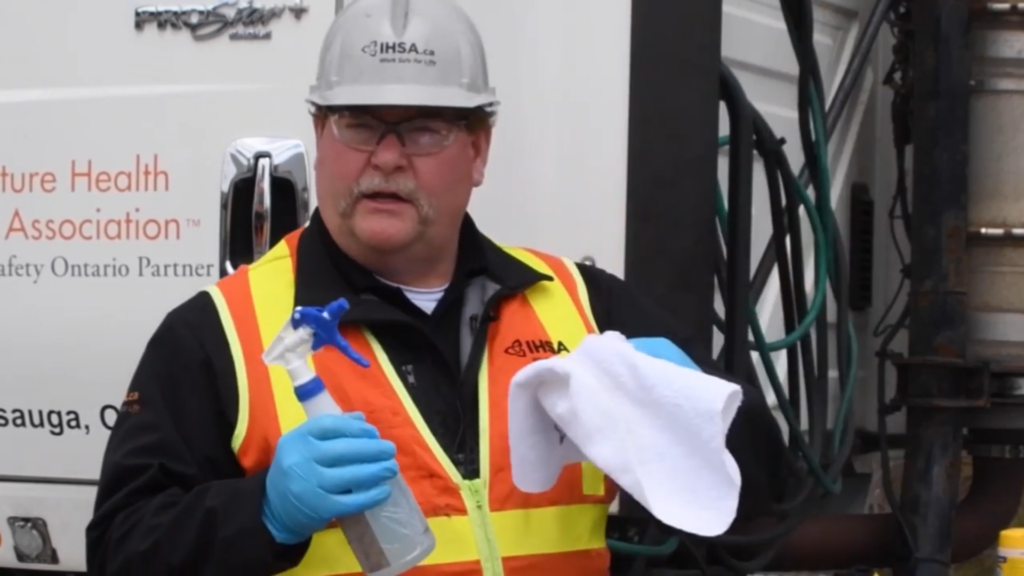Social distancing, and sharing space in a 2.6m truck cab
MISSISSAUGA, Ont. — Public health officials want people to keep two meters away from one another to fight the spread of Covid-19. That’s pretty difficult to do in a truck cab restricted to a maximum width of 2.6 meters overall.
Ontario’s Infrastructure Health and Safety Association (IHSA) – in a partnership with Concrete Ontario, the Truck Training Schools Association of Ontario (TTSAO), and other stakeholders — has responded with guidelines for in-vehicle driver safety in the midst of Covid-19.

“The release of IHSA’s training guidelines is intended to support those training centres that have been allowed to open,” says Enzo Garritano, the association’s president and CEO. “IHSA has worked diligently to ensure procedures are in place at our own facilities to keep instructors and participants safe. These guidelines are a starting point for training organizations to establish best practices moving forward.”
“Because employees will be required to be within two metres of one another while in the vehicle, it is critical that all employees complete a health screening at both the start and end of their shift,” the guidelines say, referring to needs that emerge during in-vehicle assessments and mentorships. Such screening is also to include temperature checks where possible.
“If either employee or trainee fails to complete all stages of the screening protocol, then the in-vehicle session should be rescheduled to a later date.”
The IHSA – part of Ontario’s occupational health and safety system, serving sectors under the province’s Workplace Safety and Insurance Board — has begun to reopen facilities and is gradually resuming its own training, with limits of one four-person class per facility.
Recognizing that virtual training can’t be used for all of a truck driver’s training, IHSA does note that options for some of the work can include virtual classrooms using tools such as Zoom, Microsoft Teams, Google Hangouts, Skype and WebEx.
“Many of these interactive systems also offer knowledge verification (testing) features, to ensure that key training objectives are understood,” it adds.
CB radios, hands-free cell phones, and in-vehicle tablets can also make it possible for trainers and mentors to communicate with drivers from outside the vehicle, the IHSA says.
“For fully licensed drivers, an instructor/mentor can follow in a separate vehicle at a safe distance and provide feedback/coaching after the trip is completed.”
When remote and virtual training isn’t possible, the IHSA recommends laying out training rooms to accommodate physical distancing, and offering workers masks and eye protection when physical distancing isn’t possible. It also calls for training room surfaces to be disinfected before and after any training session, encouraging drivers to bring their own pens and pencils, and adopting digital documents in the place of paper handouts.
“Begin and end each shift by cleaning the inside of your vehicle with a disinfectant. Clean and disinfect the steering wheel, frequently used levers, buttons and radio controls, seats, and anything generally touched with your hands,” the IHSA advises. It’s also developed an instructional video to show how to best clean and sanitize commercial vehicles.
“When cleaning the vehicle, ensure adequate ventilation by keeping the doors open, and when possible allow time for the vehicle to air out before driving (10 minutes),” the IHSA says.
In addition to equipping vehicles with hand sanitizer and disinfectant spray, and containers to dispose of used PPE and cleaning supplies, the association also recommends driving the shared truck cabs with open windows. Each window should also be open by the same amount to equalize the pressure inside.
General precautions call on drivers to monitor their health and stay home even if they face mild symptoms such as a cough, fever or sore throat; keeping at least two meters away from others during interactions; disinfecting common or shared touch surfaces; and washing hands for 20 seconds or using a hand sanitizer with at least 60% alcohol.
- This article has been updated to include comments from Enzo Garritano.
Have your say
This is a moderated forum. Comments will no longer be published unless they are accompanied by a first and last name and a verifiable email address. (Today's Trucking will not publish or share the email address.) Profane language and content deemed to be libelous, racist, or threatening in nature will not be published under any circumstances.